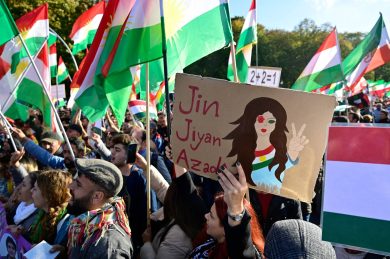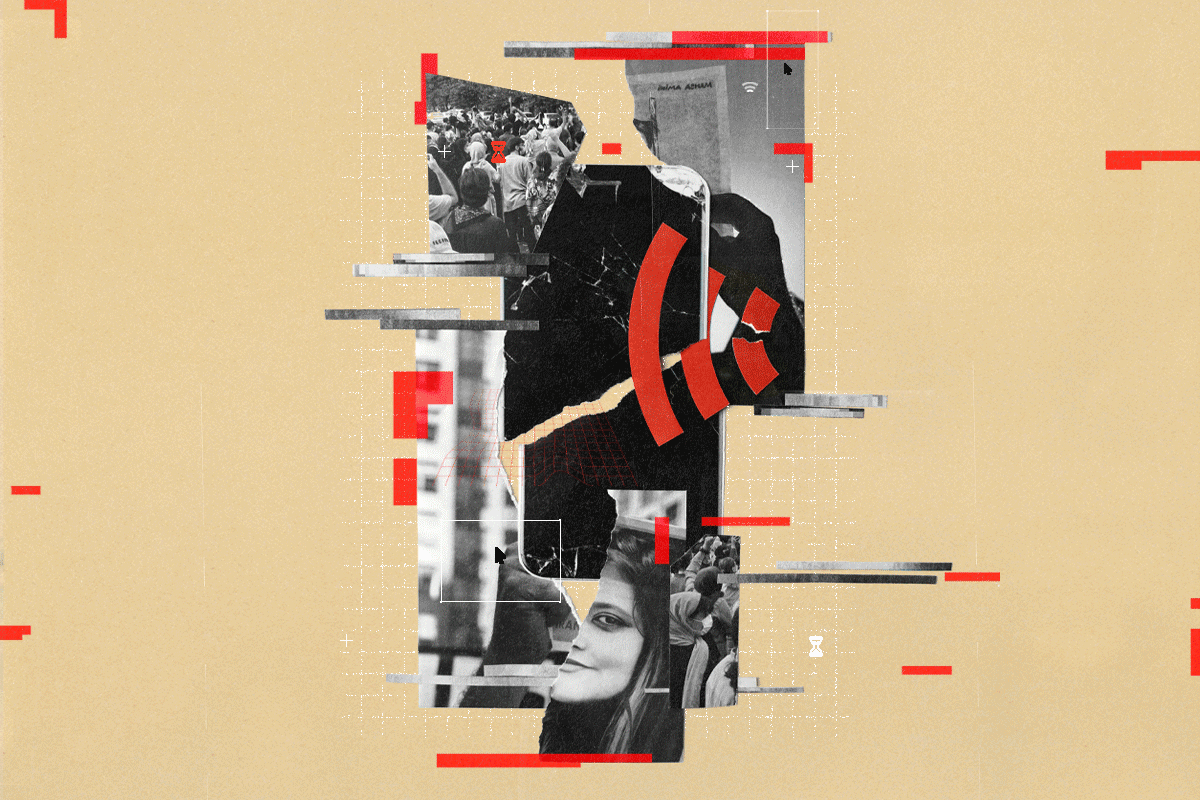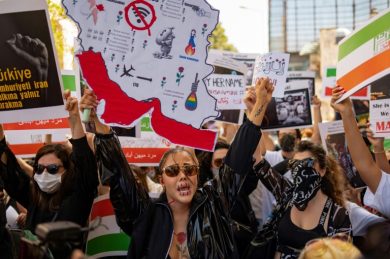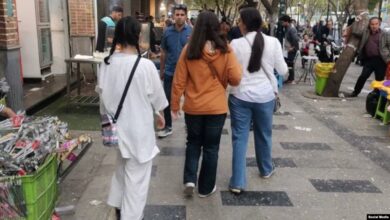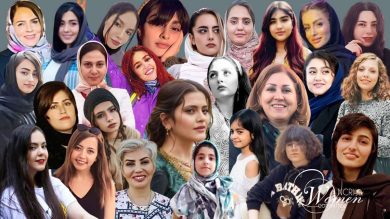When 22-year-old Mahsa Jina Amini died in custody on September 16, 2022, after being arrested by Iran’s so-called “morality police,” it ignited the largest uprising in the Islamic Republic’s history. The spark was a young Kurdish woman—beaten for “improper hijab.” The fuel was decades of systemic repression, surveillance, and state violence against Iranian women, enforced in large part by the Islamic Revolutionary Guard Corps (IRGC) and its affiliated Basij militia.
The slogans that followed—“Woman, Life, Freedom”—became a rallying cry not only against compulsory hijab but against a regime that has, since 1979, treated women’s bodies as battlegrounds and their agency as threats to national security.
This article traces a timeline of IRGC repression against women, from the foundations of gender apartheid to the brutal crackdown that continues today. It is a record of suffering—and resistance. Of fear—and defiance.
1. 1979–1983: The Revolution Turns Against Women
Shortly after the Islamic Revolution, the new regime led by Ayatollah Khomeini began institutionalizing gender-based restrictions.
Key Events:
• March 1979: Mandatory hijab decreed for all women in government offices
• 1980–81: Gender segregation enforced in schools, public transport, and universities
• 1983: Parliament passes the Islamic Penal Code, criminalizing unveiled women with lashes, fines, or imprisonment
Though the IRGC was still forming, it quickly became a key enforcer of these edicts, embedding Basij units in neighborhoods to monitor women’s dress and behavior.
2. 1980s–1990s: The Morality Machine Expands
During and after the Iran-Iraq War, the IRGC gained tremendous power. Its Basij militia became a cultural force, operating “neighborhood patrols” to enforce Islamic morality.
Impact on Women:
• Basij monitored homes for parties, unveiled gatherings, or “un-Islamic” behavior
• Women were barred from singing solo in public, banned from stadiums, and restricted in media
• Female athletes were forced into restrictive clothing, and career advancement was often limited to regime loyalists
Through media, sermons, and surveillance, the IRGC shaped women’s roles: obedient, invisible, and silent.
3. 1999: Student Protests and the Feminist Undercurrent
The 1999 student uprising, sparked by press freedom issues, saw many female students at the forefront. The IRGC’s response was brutal:
• Basij stormed university dorms
• Dozens of women were arrested, sexually harassed, or beaten
• Prominent women’s rights advocates were later targeted for “acting against national security”
Though the protests were crushed, they planted seeds for the women-led Green Movement a decade later.
4. 2005–2009: Ahmadinejad’s Rise and Renewed Crackdown
Under IRGC-backed President Mahmoud Ahmadinejad, state enforcement of hijab and morality laws intensified.
Basij Role:
• Launched the “Guidance Patrol” (Gasht-e Ershad) to arrest women for improper hijab
• Deployed female Basij agents to monitor women in schools, malls, and public parks
• IRGC media outlets vilified feminist activists as “Western agents”
During this period, brave women like Nasrin Sotoudeh, Narges Mohammadi, and Shirin Ebadi rose in global prominence—at the cost of imprisonment, exile, or constant surveillance.
5. 2009: The Green Movement and the Silencing of Women
The contested presidential election of 2009 triggered mass protests. Once again, women were at the frontlines—and bore the brunt of the crackdown.
IRGC Response:
• Mass arrests, including prominent female journalists and lawyers
• Dozens of women reported rape and torture in detention
• Taraneh Mousavi, a young woman detained during protests, was found dead and mutilated—her case became emblematic of the regime’s brutality
This moment confirmed the IRGC’s willingness to treat women’s political participation as existential threats.
6. 2014–2019: The Rise of Digital Feminism
In the late 2010s, women began using social media to reclaim their voice—often anonymously, often bravely.
Key Campaigns:
• #MyStealthyFreedom: Women posted unveiled photos from inside Iran
• White Wednesdays: A weekly act of unveiled defiance, captured on video
• Girls of Revolution Street: Women publicly removed hijabs on street corners
The IRGC responded with:
• Arrests and prison sentences (e.g., Yasaman Aryani, Monireh Arabshahi, Mojgan Keshavarz)
• Surveillance and hacking of women’s online accounts
• Sexual humiliation in custody to “correct” their behavior
The digital sphere became a battlefield of ideology and fear.
7. November 2019: Massacre and the Gendered Repression
In response to rising fuel prices, protests erupted in over 100 cities. The IRGC and Basij killed over 1,500 people in days.
Among the victims:
• Dozens of women, including mothers, students, and children
• Reports emerged of sexual violence in detention centers
• Female journalists and medics targeted for documenting abuse
One nurse reported, “They beat a pregnant woman until she miscarried. When I tried to help, they beat me too.”
The regime viewed women’s presence not just as disobedience—but as contamination.
8. 2022: Mahsa Amini and the Spark of Revolution
On September 13, 2022, Mahsa Amini was arrested by Gasht-e Ershad in Tehran. Three days later, she was dead.
The regime claimed natural causes. Her family and medical reports pointed to blunt trauma to the skull.
What Followed:
• Protests in over 140 cities led primarily by women
• Viral videos of women burning hijabs and cutting hair
• Global solidarity marches under the banner of “Woman, Life, Freedom”
The IRGC responded with unprecedented force:
• Over 500 killed
• More than 20,000 arrested
• Children as young as 12 detained and tortured
• Chemical attacks on girls’ schools, likely by IRGC-linked groups
9. 2023–2024: The Regime Strikes Back
Even after protests subsided, the IRGC continued targeting women:
Tactics:
• New “Hijab Surveillance Units” using facial recognition in public spaces
• Re-arrest of high-profile female activists, including Narges Mohammadi and Sepideh Qoliyan
• Travel bans and house arrest for outspoken women
• Mass disinformation campaigns online accusing feminists of “Zionist agendas”
The IRGC also expanded digital repression, tracking VPN usage and cracking down on journalists abroad.
10. The Ongoing Fight: Women Defying the IRGC in 2024
Today, Iranian women remain at the forefront of resistance—inside and outside the country.
Notable Frontlines:
• Inside Iran: Teachers, nurses, and students organizing underground protests
• In Exile: Diaspora women leading campaigns for sanctions, IRGC designation, and legal justice
• In Courts: Survivors filing lawsuits under universal jurisdiction for sexual torture, unlawful detention, and discrimination
Despite arrests, harassment, and smear campaigns, women continue to redefine revolution itself.
Global Response: Too Little, Too Slow
While international outcry after Mahsa’s death was strong, policy action remains weak:
• The IRGC is still not designated as a terrorist organization by the EU, UK, or Canada
• Female activists face deportation threats or legal hurdles in asylum systems
• No international tribunal has been created for sexual violence or political imprisonment
The women risking everything deserve more than statements—they deserve protection, prosecution of abusers, and permanent structural change.
Conclusion: Their Names, Our Responsibility
From Mahsa Amini to Neda Agha-Soltan, from Nasrin Sotoudeh to anonymous schoolgirls poisoned for protesting—the story of women in Iran is one of courage against tyranny.
The IRGC’s war on women is not only ideological. It is legal, digital, physical, and psychological. And it continues every day that the world remains silent.
Join Our Newsletter!
Stay informed with the latest updates, news, and ways to take action in the fight for justice and global security. Sign up now to get updates delivered straight to your inbox!

